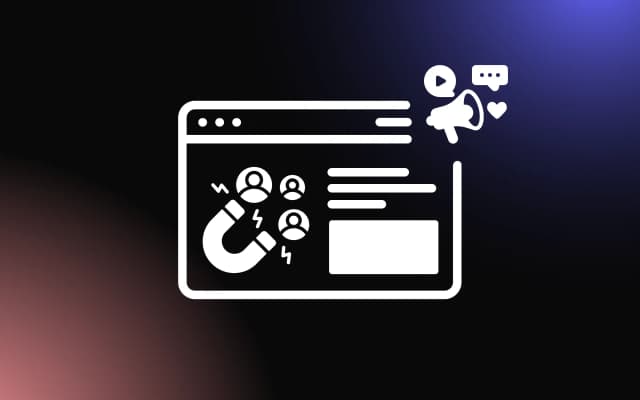
Too many e-commerce businesses watch potential customers visit their sites, browse products, and leave without buying anything. This happens when websites fail to create clear paths from initial interest to final purchase. Without proper funnel structure, even high-quality products and competitive prices cannot generate consistent sales.
The solution is building a strategic ecommerce sales funnel that guides visitors through each stage of the buying journey. A properly constructed funnel addresses customer concerns, builds trust, and removes barriers to purchase at every step. This systematic approach converts more visitors into buyers and increases the value of each customer over time.
In this article, we will explore how to create an effective ecommerce sales funnel using proven strategies and interactive tools that maximize conversion rates.
Understanding the Ecommerce Sales Funnel
An ecommerce sales funnel represents the journey customers take from first discovering your brand to making purchases and becoming repeat buyers. This process includes multiple stages where visitors move from awareness to consideration to decision and finally to action. Each stage requires different approaches to keep potential customers engaged and moving forward.
The awareness stage captures attention from people who might need your products but do not know your brand exists. This stage focuses on attracting qualified traffic through search engines, social media, advertising, and content marketing. Success here means getting the right people to visit your website.
During the consideration stage, visitors evaluate your products against alternatives and decide whether your offerings meet their needs. This phase requires detailed product information, comparisons, reviews, and trust signals. Visitors need enough information to feel confident about potential purchases.
The decision stage involves visitors choosing specific products and preparing to buy. Price comparisons, shipping information, return policies, and payment options become crucial factors. Any friction or uncertainty at this point can cause customers to abandon their carts.
The action stage completes transactions and begins customer relationships. Smooth checkout processes, clear confirmations, and immediate follow-up communications ensure positive experiences. This stage also sets foundations for future purchases and referrals.
Post-purchase stages focus on customer retention through excellent service, follow-up communications, and opportunities for additional purchases. Satisfied customers often become repeat buyers and brand advocates who refer others to your business.
Understanding these stages helps you design specific strategies for each phase of the customer journey. Different tactics work better at different stages, so matching approaches to customer mindsets improves overall ecommerce sales results.
Attracting Qualified Traffic to Your Ecommerce Sales Funnel
The top of your ecommerce sales funnel depends on attracting visitors who are likely to become customers. Quality traffic consists of people actively searching for solutions your products provide, not just random browsers who stumble upon your site accidentally.
Search engine optimization brings targeted visitors who are already looking for products like yours. When people search for specific items or related keywords, appearing in search results connects you with high-intent prospects. These visitors often convert better than traffic from other sources.
Content marketing builds awareness among potential customers who might not be ready to buy immediately. Blog posts, guides, videos, and tutorials attract people researching solutions to problems your products solve. This approach creates longer-term relationships that eventually lead to sales.
Social media marketing reaches customers where they spend time online. Platforms like Facebook, Instagram, and Pinterest allow targeting based on interests, demographics, and behaviors. Visual products often perform especially well on image-focused social networks.
Paid advertising provides immediate traffic from specific audiences. Google Ads, Facebook Ads, and other platforms let you target people based on search terms, interests, and past behaviors. Paid traffic can complement organic efforts while you build long-term visibility.
Email marketing maintains connections with people who have shown interest in your products. Newsletter subscribers and previous customers represent warm audiences more likely to make purchases than cold traffic. Regular communication keeps your brand visible when people are ready to buy.
Referral programs encourage existing customers to bring new visitors to your site. Word-of-mouth recommendations carry more weight than advertising, and referred customers often have higher lifetime values than other acquisition channels.
Interactive content can significantly boost traffic quality and engagement. Quizzes help visitors discover products that match their specific needs while collecting valuable data about preferences and requirements.
Creating Compelling Product Pages for Ecommerce Sales
Product pages serve as crucial decision points in your ecommerce sales funnel where visitors determine whether to add items to their carts. These pages must provide complete information while addressing concerns that prevent purchases.
High-quality product images show items from multiple angles and demonstrate use cases. Professional photography builds trust and helps customers understand exactly what they will receive. Poor images create uncertainty that leads to abandoned carts and returns.
Detailed product descriptions answer questions customers have before buying. Include dimensions, materials, care instructions, and compatibility information. Think about what you would want to know before purchasing similar items yourself.
Customer reviews and ratings provide social proof that influences buying decisions. Display both positive and negative reviews to build credibility. Address negative feedback publicly to show excellent customer service and transparency.
Clear pricing information eliminates surprises that cause cart abandonment. Show base prices, shipping costs, taxes, and any additional fees upfront. Hidden costs discovered during checkout frustrate customers and damage trust.
Stock availability indicators create urgency and prevent disappointment. Show current inventory levels and expected restock dates for out-of-stock items. This information helps customers make informed timing decisions.
Related product suggestions can increase order values by showing complementary items. Display products that other customers frequently buy together or alternatives if preferred items are unavailable.
Easy-to-find size charts, specifications, and comparison tools help customers choose correctly. Reducing uncertainty decreases returns and increases satisfaction with purchases.
Interactive elements like product configurators allow customers to customize options and see results immediately. These tools reduce uncertainty while increasing engagement with your products.
Building Trust Through Your Ecommerce Sales Process
Trust represents the foundation of successful ecommerce sales funnels. Customers must feel confident about sharing personal information and payment details before completing purchases. Multiple trust signals throughout your site reinforce security and reliability.
Professional website design creates positive first impressions that influence trust levels. Clean layouts, consistent branding, and error-free content suggest attention to detail and business competence. Poorly designed sites raise questions about legitimacy.
Security badges and certifications show customers that their information will be protected. Display SSL certificates, payment processor logos, and security certifications prominently on checkout pages. These visual cues reduce anxiety about online transactions.
Contact information and customer service options demonstrate accountability and support availability. Include phone numbers, email addresses, chat options, and physical addresses. Multiple contact methods suggest established businesses committed to customer satisfaction.
Clear return and refund policies reduce purchase risk and show confidence in product quality. Generous policies often increase sales by removing barriers to trying products. Explain processes clearly and honor policies consistently.
Customer testimonials and case studies provide social proof from real buyers. Include photos, names, and specific details when possible to increase credibility. Video testimonials often carry more weight than written reviews.
About us pages tell your company story and introduce team members. Personal connections build trust and differentiate your business from anonymous competitors. Share your mission, values, and commitment to customer satisfaction.
Professional email communications throughout the buying process reinforce trust and keep customers informed. Send order confirmations, shipping notifications, and delivery updates promptly. Clear, helpful messages create positive experiences.
Contact forms with immediate response commitments show customer service priorities. Quick responses to inquiries build confidence and often lead to faster purchase decisions.
Optimizing Your Ecommerce Sales Checkout Process
The checkout process represents the final opportunity to complete ecommerce sales or lose customers to cart abandonment. Every friction point or confusion element can cause customers to leave without purchasing, making optimization crucial for funnel success.
Simplified checkout flows reduce abandonment by minimizing required steps and information. Allow guest checkout options for customers who do not want to create accounts immediately. Account creation can happen after purchase completion when customers feel more invested.
Multiple payment options accommodate different customer preferences and increase completion rates. Accept major credit cards, PayPal, digital wallets, and buy-now-pay-later services when possible. More options mean fewer customers cannot complete desired purchases.
Clear progress indicators show customers how many steps remain in the checkout process. Uncertainty about process length causes anxiety and abandonment. Simple progress bars or step counters keep customers informed and motivated to continue.
Mobile optimization ensures smooth experiences on phones and tablets where increasing numbers of customers shop. Test checkout flows on different devices regularly to identify and fix mobile-specific issues that prevent purchases.
Error handling and validation help customers correct mistakes without frustration. Highlight required fields clearly, explain formatting requirements, and provide helpful error messages when problems occur. Poor error handling causes significant abandonment.
Shipping options and costs displayed early in checkout prevent surprises that cause abandonment. Offer multiple speed and cost options when possible. Free shipping thresholds can encourage customers to add items to qualify for better deals.
Security reassurances during payment entry reduce anxiety about sharing sensitive information. Display security badges, use secure connections, and explain how customer data is protected throughout transactions.
Order summary reviews let customers verify purchase details before finalizing transactions. Include product images, quantities, prices, shipping costs, and total amounts clearly. Easy editing options allow quick corrections without starting over.
Leveraging Email Marketing in Your Ecommerce Sales Funnel
Email marketing provides one of the most effective ways to increase ecommerce sales throughout your funnel. Strategic email campaigns nurture prospects, recover abandoned carts, and encourage repeat purchases from existing customers.
Welcome email series introduce new subscribers to your brand and products. These automated sequences should provide value while gradually building interest in your offerings. Include best-selling products, company story, and exclusive subscriber benefits.
Abandoned cart emails remind customers about items they considered buying but did not purchase. These messages often include product images, customer reviews, and limited-time incentives to encourage completion. Multiple follow-up emails typically outperform single messages.
Browse abandonment emails target visitors who viewed products but did not add them to carts. These campaigns re-engage interested prospects with relevant product information and incentives to return and purchase.
Post-purchase email sequences confirm orders, provide shipping updates, and request reviews or feedback. These communications build confidence and encourage future purchases through positive experiences and engagement.
Win-back campaigns target customers who have not purchased recently. These emails often include special offers, new product announcements, or surveys to understand why customers stopped buying. Re-engagement can recover previously lost customers.
Personalized product recommendations based on purchase history and browsing behavior increase relevance and response rates. Dynamic content shows different products to different customers based on their interests and past behaviors.
Seasonal and promotional campaigns capitalize on holidays, sales events, and new product launches. These messages create urgency and provide reasons for customers to visit your site and make purchases.
Newsletter content that provides value beyond sales messages builds long-term relationships and brand loyalty. Include tips, tutorials, and industry insights that benefit subscribers regardless of whether they make immediate purchases.
Using Social Proof to Boost Ecommerce Sales
Social proof influences customer behavior by showing what other people do and think about your products. Multiple forms of social proof throughout your ecommerce sales funnel build confidence and encourage purchases from hesitant prospects.
Customer reviews on product pages provide honest feedback from real buyers. Encourage reviews through follow-up emails and incentives, then display them prominently. Respond to both positive and negative reviews to show active customer engagement.
User-generated content showcases real customers using your products in authentic settings. Encourage customers to share photos and videos on social media, then feature this content on your website with permission. Authentic content often influences purchases more than professional marketing materials.
Sales notifications and recently purchased items create urgency and show product popularity. Display messages like "5 people bought this item in the last hour" to suggest demand and encourage faster decisions.
Social media follower counts and engagement metrics demonstrate brand popularity and customer satisfaction. Display social media feeds or follower numbers on your website to show active communities around your products.
Press mentions and awards provide third-party validation of your business and products. Feature media coverage, industry awards, and expert recommendations prominently to build credibility with new customers.
Customer testimonials with specific details and results create emotional connections with prospects. Video testimonials often carry more weight than written ones because they feel more personal and authentic.
Influencer partnerships and endorsements leverage existing audiences and trust relationships. Work with influencers whose followers match your target customers for maximum impact and authenticity.
Trust seals and certifications from recognized organizations show commitment to quality and customer protection. Display relevant badges and certifications prominently throughout your site, especially during checkout processes.
Analyzing and Improving Your Ecommerce Sales Funnel
Continuous analysis and optimization keep your ecommerce sales funnel performing at peak effectiveness. Regular monitoring identifies problems and opportunities that impact conversion rates and overall sales performance.
Conversion rate tracking at each funnel stage reveals where customers drop off most frequently. Calculate rates for page visits to email signups, email signups to first purchases, and first purchases to repeat purchases. These metrics guide optimization priorities.
Cart abandonment analysis identifies specific points where customers leave without completing purchases. Review checkout analytics, heat maps, and user recordings to understand why people abandon carts and what changes might help them complete transactions.
Customer feedback collection through surveys and reviews provides qualitative insights to complement quantitative data. Ask customers about their experience, what nearly prevented their purchase, and what convinced them to buy.
A/B testing compares different versions of pages, emails, and processes to determine which approaches work best. Test headlines, images, button colors, pricing displays, and checkout flows to find combinations that maximize conversions.
Customer lifetime value calculations help you understand how much to invest in acquiring new customers and retaining existing ones. Higher lifetime values justify higher acquisition costs and more extensive retention efforts.
Funnel visualization tools show customer paths through your site and identify common drop-off points. Google Analytics, heat mapping software, and specialized funnel analysis tools provide different perspectives on customer behavior.
Cohort analysis tracks how different customer groups behave over time. Compare customers acquired through different channels, during different periods, or with different characteristics to optimize acquisition and retention strategies.
Mobile analytics deserve special attention since mobile commerce continues growing rapidly. Analyze mobile-specific metrics and optimize mobile experiences to capture this increasing traffic segment effectively.
Transform Browsers Into Loyal Customers with Strategic Funnel Design
Building an effective ecommerce sales funnel requires strategic thinking about each stage of the customer journey. From initial awareness through post-purchase retention, every touchpoint influences whether visitors become customers and whether customers become advocates for your brand.
The most successful online stores view funnel building as an ongoing process rather than a one-time setup. They continuously test new approaches, analyze performance data, and adapt strategies based on customer feedback and behavior patterns. This commitment to optimization separates thriving e-commerce businesses from those that struggle to grow consistently.
Start implementing these funnel strategies today and watch your ecommerce sales climb steadily. Your customers will appreciate the smoother buying experience, and your business will benefit from improved conversion rates and stronger customer relationships that drive long-term success.


